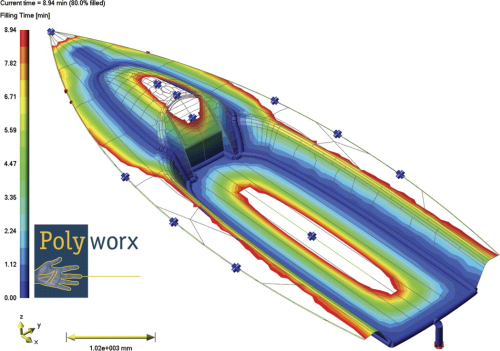
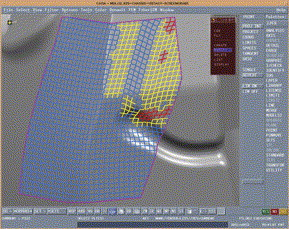
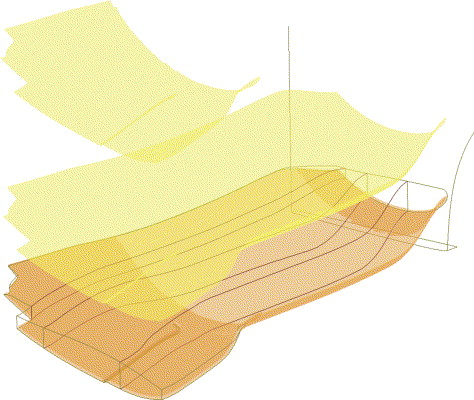
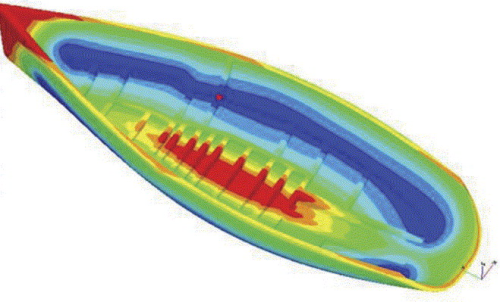
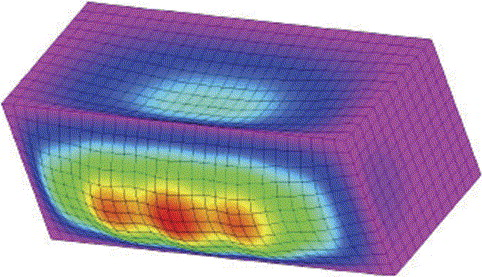
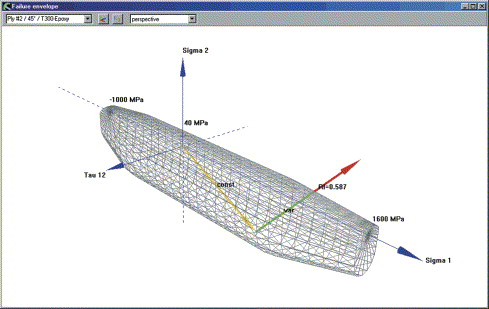
Among the 900 exhibitors at the recent JEC Composites Show in Paris were a large number of companies whose products include software for use in the composite industry. The software products available now include design suites that work with existing computer aided design (CAD) packages, laminate design and analysis packages, finite element analysis (FEA) packages, structural optimisation software, software for resin transfer moulding (RTM), estimation software and others. Many of these products started in the high-tech aerospace end of the composites market, but now the advantages of these programs are being utilised in other applications such as automotive, marine and wind energy as well. Following are highlights of some of the software at the show.
VISTAGY
To highlight their customers in automotive as well as aerospace, VISTAGY Inc exhibited a Renault F1 Team racecar on their stand. The Renault F1 Team has used VISTAGY's FiberSIM® software to advance the design and manufacture of composite components on three generations of racecars, including the R25 car, which in 2005 raced the team to victory in both the Federation Internationale de l'Automobile (FIA) Formula One Drivers' and Constructors' World Championships. Alan Duerden, CAD support engineer for the team, also gave a presentation titled Champion cars, composite parts, and FiberSIM.
The World Champion Renault F1 Team based in Enstone, England, continues to use FiberSIM software to design and manufacture composite parts for its R26 racecar, which the Renault team launched in Monaco in January of 2006. The Renault F1 Team is a wholly-owned division of Renault SA, headquartered in Paris, France.
“The composite parts on our racecars must be strong, reliable, and built to strict Federation Internationale de l'Automobile standards,” says Bob Bell, technical director for Renault F1 Team. “But we also have a gruelling production schedule to meet. There is no margin for error and we have no time for rework and up-front physical proto-typing. We've been working with FiberSIM for more than three years, and it has helped our engineers increase our rate of composite ply lay-up on some parts by over 62%. The software is an essential tool for efficiently and successfully producing our composite components.”
“It has been an honour to sponsor Renault F1 Team for the past three years and especially during its championship season last year,” says Steven C. Luby, president and CEO of VISTAGY. “We look forward to continuing our relationship with Renault F1 Team and providing specialised software that makes their engineers more efficient as they make another drive toward the winner's circle.”
Strong, lightweight composites are ideal materials for Formula One racecar parts such as the chassis, nosebox, and front and rear wings. The complex curves characteristic of these parts can present some challenges during manufacturing. FiberSIM enables Renault F1 Team engineers to simulate composite designs and select a manufact-uring strategy that is best suited for their specific application. The software enables the team to generate flat patterns of plies for cutting machines, create documentation, and export data to laser projection machines that guide manual lay-up.
FiberSIM is a suite of software that turns commercial CAD systems into tools specialised for designing and manufacturing composite parts. The software enables engineers to create a complete digital product definition of a composite part within their 3D modelling environment. FiberSIM supports the entire product development process as well as flexible design methodologies for a wide variety of materials and manufacturing methods. The software simulates how composite material deforms over complex curvature and generates manufacturing information including documentation, flat patterns, and data to drive downstream manufacturing equipment. FiberSIM also uses XML technology to share composites data with people and applications throughout the enterprise.
FiberSIM works with the Catia V5, Pro/Engineer 2001 & Wildfire and the Unigraphix NX CAD systems. It supports most composite manufacturing methods including hand lay-up, forming, tape laying and fibre placement.
According to VISTAGY, the latest version of FiberSIM, version 5.1 provides three primary advantages:
- Automation earlier in the product development process. Engineers who produce large or complex composite parts utilise FiberSIM to help them design and validate laminates, zones, layers and ply sequences. The software provides new capabilities to automate design methods earlier in product development for more efficient manufacture of composite parts. For example, the new Merge Model capability enables engineers to quickly and automatically divide an electronically generated model, such as a representation of an aircraft fuselage, into several separate models and combine them again at a later time. This capability allows a number of engineers to simultaneously work on the parts of a large composite product to significantly decrease development time. The Symmetric Laminate Utility generates a model, such as an aircraft's composite left wing section, and then applies all the data to automatically create a corres-ponding structure for the opposite, right-hand side, saving hours of manual design time.
- Capabilities specifically designed to optimise various composites product development processes. Composite designs will not be economically feasible unless they are tailored to the specific manufacturing processes being used to produce them. The new Automated Deposition Design™ (ADD) option automates the creation of composite product geometry that is specific to manufacturing processes such as tape-laying or fibre placement, saving weeks of manual work for large structures. The new Extended Ramp Object, for example, extends boundaries of material and defines a natural drop-off to make it easier for a fibre placement machine to ‘ramp up’ onto a tool and do its job properly. FiberSIM 5.1 provides unique tools for ply lay-up, material overlay, tape-laying and splicing that optimise composite designs for quicker downstream manufacturing. There are also new documentation enhancements, such as automatic generation of 2D plybooks that list the sequence of laminate plies, eliminating drawings and manual note-taking methods used prior to FiberSIM.
- The creation of a complete product definition that can be easily leveraged downstream. Engineers can create a complete composite design definition with all associated citations and data necessary to drive downstream processes. Using the open standard Extensible Markup Language (XML), the complete data set can be easily shared across the enterprise. As a result, engineers understand the history and context of design details, which helps minimise potential errors downstream, achieve desired part quality, and meet specifications in a fraction of the time of traditional processes.
“By automating many of the most repetitive or complex composites design tasks early in development, FiberSIM 5.1 enables engineers to select the optimum product design choices and manufacturing methods to reduce cycle time and costs,” Bob Flory, vice president of product development at VISTAGY says. “As a result, our customers will realise a significant competitive advantage.”
VISTAGY software is used in the aerospace, automotive, marine, medical, sporting goods and transportation interiors industries. The company also offers training and consulting services.
Anaglyph
Anaglyph Ltd is a company with several software products for composites: Laminate Tools, CoDA and LAP. Laminate Tools is an affordable Windows product that integrates the design, analysis and manufacture of composites structures. CoDA assists in the preliminary stage of engineering design of panels, beams, joints, flanges and laminates, as well as in composite material synthesis for mechanical properties. CoDA is a product of the Composites Group at the National Physical Laboratory in England. LAP is a software tool for the in-depth analysis and design of composite material laminates.
Laminate Tools new version 3.1, is Windows based software, which can use information from a CAD system to define surfaces, and then perform material draping simulations. It can use selected FEA pre-processor applications (currently supports Nastran or Ansys FEA systems) to import the FE mesh, then drape all surfaces with composite fabric and build the lay-up for the entire structure. It can convert the ply information to layered material properties suitable for FE analysis, and use this information with the FEA applications. It can post-process the results of FE analyses in ways that are specific to composite materials, including the ability to examine the individual full global plies. It can then use the ply information for manufacturing – export the flat ply patterns for nesting and cutting, or project (using laser equipment) the ply outlines on the mould surface during manufacture.
Laminate Tools can also be used to view, review and approve the structural characteristics during design, and communicate the information digitally across departments or subcontractors.
Laminate Tools is modular and consists of five modules. The View module exhibits read-only viewing functionality that allows for easy, in-depth examination and understanding of the composite design. The other four modules – Design, Analysis, Check, and Manufacture – extend the product's functionality by creating ply and lay-up material information, FE laminate properties, checking FEA stress results, generating failure indices, exporting ply patterns and enabling information flow between third-party applications.
“Our Laminate Tools customers come from the aerospace, Formula 1 and automotive, marine, and wind energy sectors,” says Dr George Kretsis, managing director of Anaglyph. “We have developed and priced Laminate Tools to make it useable by and affordable to small companies too, effectively bringing cutting edge aerospace technology to all serious composites professionals. By using industry-standard formats and 100% compatibility with the already established big names, we allow our users to join the technology of ply-by-ply design, analysis and manufacture simulation.”
“The features available in Laminate Tools can cost an order of magnitude more in alternative solutions (draping, FEA interfaces, bespoke post-processing, electronic plybook, laser projections, etc,” Kretsis. “In addition, all the features are available within a single product, from one vendor.”
ESI Group
ESI Group showcased its software for composites on its JEC stand – SYSPLY, PAM-RTM and PAM-FORM. SYSPLY is a simulation tool for the design of composite material structures consisting of multiple plies of varying pattern. PAM-RTM, simulates the manufacturing process of resin injection through fibrous reinforcements, known as resin transfer moulding (RTM). PAM-FORM is software for the simulation of the thermoforming of plastics and composites.
A customer of ESI Group, Poncin Yachts, is developing and producing a modern range of 9-15 m long sailing boats using high-performance and computer-controlled tooling organised around resin transfer moulding and vacuum infusion for making composite hulls and decks. PAM-RTM software has made it possible to design and develop new tooling for composite materials production lines using ‘closed mould’ technology. This technique enables parts of an enhanced quality and a very shiny final appearance to be obtained. The combined use of RTM and vacuum infusion guarantees an excellent degree of homogeneousness of the resin in all the compartments of the mould for greater rigidity and a constant weight. All the parameters are managed by automated controllers connected to sensors which provide continuous monitoring of temperatures, pressures, volumes, etc.
The closed mould also offers an advantage for environmental and human protection. The resin is injected under vacuum, so any harmful or noxious emanations from volatile organic compounds (VOCs) are contained, allowing a reduction in the emission rate to less than 10 ppm. That rate is two times less than the requirements of the future European standard which will be applied in 2007.
“With PAM-RTM, Poncin Yachts is able to anticipate potential manufacturing problems which could not previously be simulated when large parts were being designed,” Patrick de Luca, head of Composite Materials Solutions with the ESI Group says.
Poncin Yachts has invested more than €17 million in its modern factory spread over an area of 10 000 m2, recruited more than 170 people since the beginning of the project, and set up a production and quality control model usually found only in the automobile and aeronautics industries. This model makes it possible to reduce costs and development lead times as well as optimise industrial capacities by operating around the clock.
Polyworx
Polyworx software product, RTM-Worx, is a Windows-based program that uses the finite element method (FEM) to solve the physical equations that govern flow of a resin through a porous medium. It is designed to be used for part and process optimisation by engineers with knowledge of the RTM process, but who are not specifically trained in FE methods. RTM-Worx is a very fast, reliable, robust and accurate combined Finite Element/Control Volume calculation core in combination with a goal-centred user interface. Geometry editor, pre- and post-processor and the solver are completely integrated.
Arjen Koorevaar of Polyworx points out some of the new features in the software: “Some of the recent developments are the SALT scripting interface to support on-line real time model-based control which was developed in the COMPROME project, in the EU STREP programme, a new open file format, WDX, to exchange data for flow analysis, optimisation for large complex parts, like wind turbine blades and tools to reduce preparation time for imported models.”
Galorath
SEER-DFM from the Galorath Corp is a software system for producing project estimates. In conjunction with Airbus, Galorath won an innovation award last year from JEC. Andrew Langridge gave a presentation during JEC this year on using the software for composite projects.
The system supports most composite manufacturing methods – hand lay-up, filament winding, braiding, and others – and also different curing and infusing methods – autoclave, RTM, VARIM, and others – as well as standard metal work manufacturing methods. The software estimates the total and average project and unit production costs for part labour, tooling, and material costs. At the manufacturing process level it also determines the key process drivers, part raw and finished weights, key process variables and their impacts on total cost, and the set up, run, rework, inspection, material, and tooling costs. It supports design for manufacture, alternative manufacturing methods and cost reduction exercises. The software is used by many of the major aerospace manufacturers including Airbus and Boeing and many of their suppliers.
Collier Research Corp
HyperSizer® from Collier Research Corp is stress analysis and sizing optimisation software for composite structures.
“HyperSizer couples automatically to FEA programs such as NASTRAN for system level studies and structural component margin-of-safety investigation,” says Craig Collier, developer of the software and president of the company. “The software solves detailed mechanical and thermal stresses/strains for metallic and composite materials, and performs detailed failure analysis of panels, beams, and joints.”
“One of the key benefits to the end user is that HyperSizer is now a third generation software package that has been taken back to the drawing board several times until we got it right,” he says. “It combines methods and software from our company, NASA, industry, and universities. We have included hundreds of analytical methods under one umbrella. HyperSizer is user friendly, well documented, and based on an integrated database.”
The software runs under Windows and generates stress reports in Microsoft Word format. HyperSizer has powerful graphics capabilities which allow computed results such as optimum panel concept and materials, margins-of-safety, critical failure modes, and critical load cases to be displayed on the FE model. The software has extensive capabilities to be interfaced with other software via Microsoft COM and ActiveX, and also allows for user developed plug-in modules for customer specific needs.
While HyperSizer is being used extensively by companies such as NASA, Boeing, Lockheed Martin and many others for aerospace applications, the software can also be used for other structures. Structural optimisation of an ISO shipping container sidewall was performed for the three loadings it must withstand to meet the ISO specification. HyperSizer sidewall sizing and material optimisation clearly shows that an 80% lighter design is possible for the sidewalls when they are made with a panel concept and carbon fibre material. The new weight is 48 kg versus the same sidewall made with steel at 247 kg. This considerable weight savings is based on extensive strength and stability optimisation.
HyperSizer was also able to automatically identify a design made from a significantly less costly fibreglass material weighing 91 kg per sidewall. This less costly design also provides increased damage tolerance.
e-Xstream engineering
DIGIMAT®, from e-Xstream engineering, is software for linear and nonlinear multi-scale material modelling. Multi-scale material modelling consists of understanding and predicting the macroscopic behaviour of a material based on the knowledge of its microstructure. DIGIMAT mean-field homogenisation enables the prediction of the material behaviour of heterogeneous and/or anisotropic materials such as composites.
DIGIMAT interfaces to major CAE Software, such as Moldflow, 3D-Sigma, Abaqus and Ansys, to provide an integrated and efficient approach to multi-scale material and structure modelling by taking into account the process-induced material microstructure in the final part structure. DIGIMAT takes as inputs the micro material properties, micro structure and loading and produces as output the composite properties for use in FEA or other downstream processing.
One typical and commonly used application of DIGIMAT is in the engineering plastics area where DIGIMAT is used to model the linear and nonlinear material behaviour of glass-reinforced thermoplastic injection moulded parts. In these cases DIGIMAT takes into account the fibre orientation predicted by injection molding software and acts as the micro-mechanical material model within the structural finite element analysis software.
“Our software is aimed at solving any problem where the material is complex (i.e. nonlinear, anisotropic and/or inhomogeneous) and end-product performance is important,” states Dr Roger Assaker, one of the co-founders of the company. “Today this includes the modelling of all kinds of structures made of reinforced plastics where we help produce an accurate prediction of the warpage (shape stability), quasi-static stiffness, vibrational response, permanent (plastic) deformation and the response to impact (high speed loading). We are now heavily investing in modelling material damage and failure under cyclic and impact loading.”
e-Xstream engineering is a ‘spin-off’ from the University of Louvain (UCL), Louvain-la-Neuve, Belgium.
e-Xstream has been doing work with automotive manufacturers to analyse the performance of long fibre injection moulded components, and other manufacturers in the areas of fibre reinforced elastomer matrix composites and metal matrix composites.
“Micromechanical material modelling is a hot topic in scientific circles, but nobody has yet brought it to this level of usage for ‘real world’ nonlinear applications,” Assaker says. “To my knowledge, we are working in a new area.”
Material
Composite Star, from Material, is composite design and database software for composite materials and structures. It calculates the properties of plies by micromechanics, the properties of laminates by Classical Laminate Theory (CLT) or Netting Analysis, the laminate load response and failure with the standard and new failure criterion and progressive failure models and the properties, load response and failure of laminated beams, tubes and plates.
Composite Star defines a constant and a variable load with the constant load typically being a preload (e.g. thermal loads resulting from curing, an external static mechanical load). The variable load is used to define a dynamic external mechanical load. This permits the calculation of the extent to which the dynamic external load can be increased until failure occurs.
Composite Star uses the ply-by-ply failure analysis in its most modern and advanced form. Besides the standard failure criteria (maximum stress, maximum strain, simple Puck, modified Puck, Tsai-Hill, Tsai-Wu, Hoffman, Hashin), Composite Star introduces one of the world's most detailed and sophisticated interactive criterion, Puck's action plane criterion. This criterion distinguishes between the different fracture modes (tensile and compressive fibre-fracture, tensile, shear and compressive inter-fibre fracture), calculates the fracture plane angle for inter-fibre fracture and can predict catastrophic wedge effects.
An additional and important tool for the designer is the display of the three-dimensional model of the failure envelope and the constant and variable stress vector for each ply. This allows immediate recognition of the stress state and reserve factor in the critical plies.
Puck's action plane failure criterion and degradation model has been tested thoroughly by university and industry research laboratories throughout the world and shows a unique conformity with reality. Furthermore, it is the new standard in VDI (the Association of German Engineers) guidelines 2014 and is recommended by the IKV (Institute for Plastic Processing), Aachen, Germany, and leading composite design experts worldwide.
Composite Star will also interface with many FEA programs. Any of the fibre, matrix, ply, laminate, stacking sequence, load or structural data can be imported or exported. Composite Star stores all data in a state-of-the-art, full-featured database. Database features include extensive searching, filtering, sorting and data import and export. The database stores the data of fibres, matrices, plies, laminates, stacking sequences, loads and structures. In addition to the physical and engineering parameters, the database can store comments and text notes.
Composite Star runs on Windows based systems. Material also provides software for filament winding and consulting services.
Future
The large number and diversity of software programs exhibited at the JEC shows that software is an accepted and necessary component of the composite industry. Companies, large and small, are now producing and using a much wider spectrum of composites specific software for design and manufacture. Software companies are working hard to incorporate theoretical and practical composite research into their software which can be utilised to improve quality, shorten lead times and facilitate larger and more complex projects. Composites manufacturing companies are realising that these advantages, many pioneered in the aerospace area, are now necessary to ensure that they remain competitive in an evolving industry.





